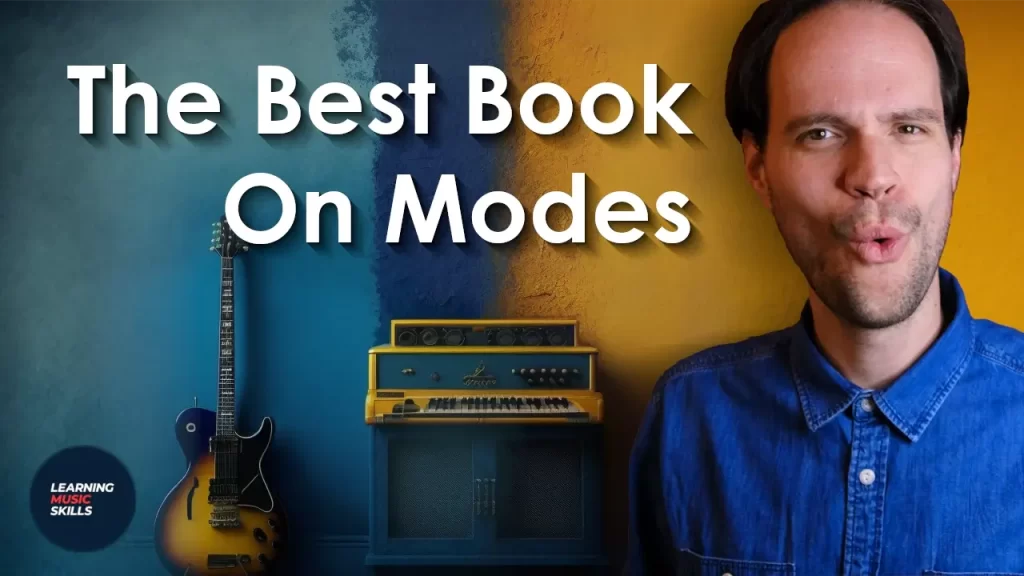Tired of playing the same melodies and leads? The musical modes are one of the most interesting ways to expand your guitar and

The free tutorials and articles from Learning
Does buying a book make you a better musician? Can you really learn and understand
Modes For Guitar by Tom Kolb
Music Theory, Songwriting and Composition Books
If you want to become a better musician, songwriter, producer, or composer, then you need to invest time in researching and learning new things. Gathering all this information by yourself is very time-consuming and difficult. So why waste time? I have curated a list of the best books on songwriting for songwriters and the best books on music composition for composers. You can also check out my best music theory books and best music production and audio engineering books list. These lists are made so that you can save time searching and start reading straight away!
About Modes for Guitar
This book was recommended to me by my guitar teacher. And I cannot thank him enough. This book on modes has given me so much. It’s hard to imagine that such a thin book can contain so much valuable information. You can find many summaries online but here is a short description:
In this one-on-one lesson, MI instructor Tom Kolb unravels the mystery of the modes, giving guitarists a complete approach to soloing and a thorough, hands-on explanation of Ionian, Dorian, Phrygian, Lydian, Mixolydian, Aeolian and Locrian. He also covers melodic minor, harmonic minor, and the blues scale; soloing over diatonic and modal progressions; superimposing modes; patterns, progressions, licks; and much more. The accompanying online audio includes 83 full-band tracks. The audio can be downloaded or streamed and includes PLAYBACK+ tools such as tempo adjustment, looping, and panning capabilities.
What I Like About This Book On Modes
Many things make reading this book a no-brainer. But what I like the best is that:
- It is to the point. So there is no fluff and only essential background information
- All exercises have notation, tabs, and chords. This means that almost anybody can follow.
- Each chapter has amazing quick reference guides
In each introduction, the writer gives us some interesting background information about the current mode that you are learning about. He gives examples of what it is most used for and why things can sound as they sound. Of course, there are far more ways that you can use each mode than he has written down. So you should see it as a short summary or excerpt.
The quick reference guides are truly amazing. They have all the information you need in less than half a page! It shows what the scale building blocks of for example the Dorian mode are. What harmonies do you have in the Dorian mode and on what scale degree? Then he also provides you with common Dorian chord progressions and five scale patterns that you can use for playing leads and writing melodies in for example the Dorian mode.
So whatever you want to learn, this book on modes is definitely a solid introduction.
Video review: Modes for Guitar by Tom Kolb
If you don’t want to read and rather watch and listen to my review of this book on modes. Then watch my review below. The video transcript can be found below at the end of this article.
Tutorials On Modal Progressions and Melodies
If you want to learn more about the musical modes and especially how to make modal chord progressions and melodies. Then check out my playlist with music tutorials on YouTube or the articles that I write on the Learning Music Skills website.
What Are Modal Chord Progressions
Modal chord progressions are a series of chords that are built around the unique qualities of musical modes, such as the Ionian, Dorian, Phrygian, Lydian, Mixolydian, Aeolian, and Locrian. An easy way to find a specific mode is to derive it from the major scale but start on different notes.
Each mode has a specific blueprint or pattern of whole and half steps. Because of this, each mode has a unique sound and mood. When it comes to chord progressions, modal chord progressions use chords that fit within the specific modal scale. Although I am not a big fan of saying that modes have a fixed sound, here’s a short overview of the different moods and tonal qualities:
- Ionian Mode (Major Scale): Happy and bright. These chords are built on the notes of the major scale.
- Dorian Mode: Has a minor feel with a raised sixth note. This creates a brighter sound.
- Phrygian Mode: Has a Spanish or ‘exotic’ quality due to its flattened second scale degree.
- Lydian Mode: Has a dreamy, active and unresolved sound due to its raised fourth degree.
- Mixolydian Mode: This is also referred to as the dominant mode. Similar to the major scale but with a lowered seventh note. Often used in rock, blues, and folk
music . - Aeolian Mode (Natural Minor Scale): Dark and melancholic. These chords are built on the notes of the natural minor scale.
- Locrian Mode: Unstable and dissonant due to its flattened second and fifth degrees. This mode is rarely used in traditional tonal
music .
Modal chord progressions emphasize the chords that naturally occur in a particular mode, emphasizing their unique sound and flavour.






